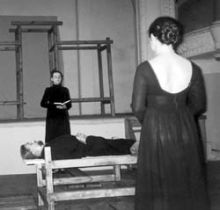Songs are the inherent foundations, the inner original source of the theater. The “goat song” of the Old Greeks, a ritual that turned into tragedy, is only one example we know from the school textbooks. In fact, songs, singing, originally included in the ritual (implying, in turn, an opposition of the protagonist and the choir) gives rise to every performing art. This is precisely why returning to the song requires special skill, for a ritual as such rules out the theater. Anatoly Vasiliev made the best of the human voice and its force in the play, Jeremiah’s Lamentation, a choral rendition of the book of the Old Testament. Even more impressive examples are found in the plays of the great Jerzy Grotowski, where singing, recitation to musical accompaniment, and movement were the inalienable components of dramatic identification, the source of that extraordinary energy which remains captivating even now, when watching tapes of his legendary works.
Grotowski’s Ukrainian pupil Natalka Polovynka, a leading soloist with the Les Kurbas Company in Lviv, also believes that songs are considerably more than the “small genre”; they are part of the artist’s vocation, as important as dramatic skill, a tool of self-realization divinely conferred. Staging plays based on folk songs, within the “Song Workshop” framework, was the next logical step after integral and beautiful solo concerts.
Natalka Polovynka and stage director Serhiy Kovalevych faced an extremely difficult task. Every song has its inner plot and its minimum dramaturgy, never complying with any such other mini vocal dramas. Using such diversified material imposes considerable limitations on the opportunity to build an image, a uniform rhythm of a performance — and without all this a performance will fall apart as so many vocal numbers. In any case, they described their production Kvitka nevista [Bridal Flower] as “a concerto for a voice and a performer,” just in case. They need not have worried.
The unity of action is achieved primarily by meticulous arrangement. Kvitka nevista begins with irmos ancient hymns lauding the Mother of God, sounding quite unusual, even strange to the modern ear, yet immediately setting the divinely elevated tone. Then the audience is brought back to earth with romantic intimate lyrics and movements just as intimate. Here the actress had cope with the difficult task of conveying her message through songs, bringing every nuance to life. Polovynka did this by a complete inner transformation. Her heroine, the Bridal Flower, is a blossoming pure soul guided by its own inner light, passing through earthly sorrows, joys, and love shared somewhere at the end of a village or on a meadow. The performance was like a magical trip secured precisely by its earthly balance. In their minimalist performance verging on nothingness (production design by Andriy Humeniuk) every gesture had to be precise and meaningful. The actor’s body turned into a moving hieroglyph, a notional line dividing the space of dramatization into what could be described as degrees of empathy. Here one finds the philosophic graphics created by Polovynka and Kovalevych; they carry the audience through not only various emotional stages, but also through all the phases of the Universe. Precisely this harmonious combination of a world of ideas and that of sensuality makes Kvitka nevista so amazingly full-bodied, lending its an inner balance and completeness. The outwardly serene yet emotionally inwardly strained central part of the performance climaxed in the heroine’s pathos, transformed into a woman wearing a shawl, sitting at the piano. Then it was back to the opening scene with a lonely figure clad in white, sitting with her back to the audience atop a “Japanese structure” (courtesy of Humeniuk), singing a strange song about the Deluge where Noah converses with the Lord as though His equal. The bride becomes a prophet. The elements, the earthly creatures, and their Creator converge in this final chord of the vocal symphony.
The Song Workshop’s second production, Vist lita [Message of Summer], marked in terms of genre as “a field of songs,” structurally resembled Kvitka nevista. Here, too, the dramatic rendition relied on songs. What made it different was the cast. While in Polovynka’s solo performance she had to dramatize numerous emotional conditions through songs, in Vist Lita every actor has his/her role. Natalka’s was accompanied by the voices of her young colleagues at the workshop: Olena Matviyenko, Ostap Kostiuk, Viktoriya Vatutina, Dana Bonchuk, Myroslava Rachynska, Zoriana Cholovska, Yuliya Romaniuk, and the “adult” partner Oleh Tsiona acting as a chaperon of sorts. Here folk songs were complimented by an urban romance, a scene from an opera by Puccini, lines from Sappho, and a present-day ingenious letter from a village. The paradox (and the greatest distinction) is that, while in Kvitka nevista the outwardly small forms became an ascent to a philosophic summit, the two-part Vist lita with its quite large cast remains a lyrical chamber drama, a poem dedicated not to a divine theme but an earthly one, including men and women.
Be it as it may, the first experiments of the Song Workshop can hardly be overestimated. For the Ukrainian theater, which has long been leading an uneventful life, the appearance of such productions combining the energy of authentic antiquity with an experimental quest, is a challenge and at the same time an assertion of the force of tradition.
In other words, still not an orchard, but already more than an oasis.








